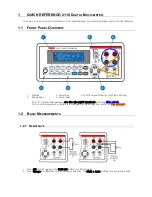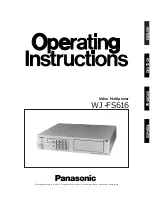
HART Multiplexer System KFD*-HM*-16
Operation
DO
C
T-0
120D
06/
2014
50
•
Extended messages and messages in the Burst Mode are recognized and used,
but not generated by the Multiplexer itself.
•
An answer buffer is available for a delayed message response. This can be used
to intermediately store a message, the command for which requires a long
execution time.
7.1.5
Loop construction/REBUILD (Software function)
On power-up, the device searches the Multiplexers in the Multiplexer table for the
connected HART field devices (commands 0 and 4
1
) and generates the internally
required access tables. This function can also be carried out by the connected
service station, as is necessary, for example, in communication with newly
connected HART field devices. The duration of this function depends on the number
of connected Multiplexer Slaves and HART field devices and also on the type of loop
search (see command 153) and the permissible number of message repeats. With
16 HART devices (e. g. by using only one Master without Slaves) the duration is
between 15 s and 30 s. The number of permissible message repeats is set to
2
in the
factory setting and the loop search type to
single analogue
.
During the REBUILD phase, only certain read commands are accepted from the
service station (commands 0, 1, 2, 3, 11, 12, 13, 48, and 129). All other commands
are followed by the response
Busy
, until the REBUILD phase ends.
7.1.6
Cyclic data interrogation/SCAN (software function)
The Multiplexer can read cyclic data from up to 31 transmitters. In this case the
SCAN option must be set for the transmitter (command 137) and the SCAN function
activated in the Multiplexer (command 149, function 1). Which data is transferred is
determined by the
SCAN command
option (command 147).
If the SCAN function is activated, the transmitters, on which the SCAN option is
activated are regularly checked for data. In this case, the SCAN command is
executed, with which one or more variables are read from the transmitter. If a field
device does not respond, it is designated as having
disappeared
(see
command 129), but it remains in the search list (i. e., it is searched for again on the
next run sequence). If a device has disappeared, but responds correctly on the next
search command, it is then listed as
appeared
. If, instead of this, another device has
answered, then the status
mismatched
is assigned.
7.1.7
Variation on the SCAN function (special SCAN function)
The Multiplexer offers in addition a second SCAN function. With this special SCAN
function (command 149, function 2) an additional parameter is used, which defines
the minimum length of the expected number of data bytes. This can be different for
each current loop, but must be set for each current loop that is to be scanned.
The SCAN function itself takes place as above, however, the response of the
transmitter is compared with the expected data length. If the length of the response is
less than the set minimum data length, the answer is rejected. If the minimum length
is 0, the answer is always saved.
7.1.8
Delay on channel change/Loop switch delay (software function when used with RPI)
If the HART Multiplexer is used with a RPI HART control module, a pause time must
be inserted when the Multiplexer channel is changed. This pause time is necessary,
since the RPI HART control module has to monitor the communication channel of the
Multiplexer and recognize the channel change. This pause time can be set by means
of command 161.
1
Command 4 is additionally used on transmitters which only support the old HART specifications up to 4.















































